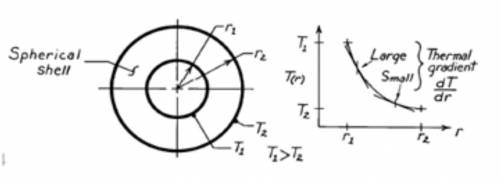
Physics, 22.02.2020 05:30 norsenorma
Determine the radial temperature distribution T(r) through a spherical shell with inner radius R1 and outer radius R2 with surface temperatures T1 and T2, respectively. Assume T1 > T2, and then sketch the relation between temperature and radius from R1 to R2.

Answers: 1


Another question on Physics


Physics, 22.06.2019 11:10
Consider an insulating crystal, made up of layers of atoms. what form would you expect the temperature dependence of the phonon heat capacity to approach at extremely low temperatures if the interlayer coupling is i)very strong (rigid coupling), and ii) very weak. explain.
Answers: 3

Physics, 22.06.2019 11:30
Water is siphoned from a large tank and discharges into the atmosphere through a 50-mm diameter tube. the end of the tube is b = 2.1 m below the tank bottom which is a = 7.4 m deep, and viscous effects are negligible. determine the maximum height h over which the water can be siphoned without cavitation occurring. atmospheric pressure is 101.4 kpa, and the water vapor pressure is 1.79 kpa (absolute)
Answers: 3

Physics, 22.06.2019 11:40
Imagine that you have two balloons (or, better yet, actually inflate two balloons, if possible). create static electricity around one of the balloons by rubbing it against your hair or your sweater and then bring that balloon close to the other balloon, which has not been charged. try this with at least one other object—and for variety in the discussion, avoid using an object already described by your classmates. then, for your initial post to the discussion, answer the following questions: what happened with the two balloons?
Answers: 3
You know the right answer?
Determine the radial temperature distribution T(r) through a spherical shell with inner radius R1 an...
Questions


Chemistry, 04.02.2020 07:43


Business, 04.02.2020 07:43



Mathematics, 04.02.2020 07:43

Social Studies, 04.02.2020 07:43

History, 04.02.2020 07:43

History, 04.02.2020 07:43



Computers and Technology, 04.02.2020 07:43


Mathematics, 04.02.2020 07:43


Mathematics, 04.02.2020 07:43

Mathematics, 04.02.2020 07:43

Biology, 04.02.2020 07:43












